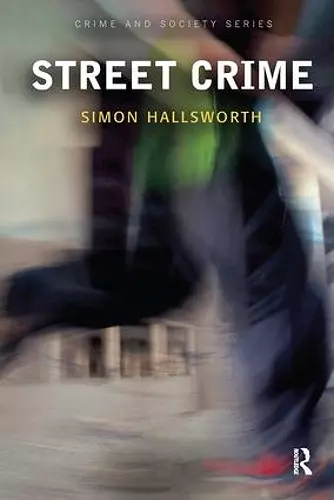Street Crime
Format:Hardback
Publisher:Taylor & Francis Ltd
Published:22nd Dec '16
Currently unavailable, and unfortunately no date known when it will be back
This hardback is available in another edition too:
- Paperback£41.99(9781843920281)

Street crime remains high on the public and political agenda, and is frequently the subject of media attention and concern. This book aims to provide a detailed and accessible account of the phenomenon, placing the subject in its theoretical, historical and political context. It addresses the question of how serious a problem street crime really is, and why it has become such a hot political issue. The book draws upon contemporary debates about the supposed presence of an emerging underclass, and in particular the 'criminalisation' and 'racialisation' of black communities with whom it has come to be particular associated in the public mind. The author then develops a framework of analysis which focuses upon the relationship of three key variables: the production of motivated offenders, the availability and suitability of victims, and a study of the limits inherent in current control strategies. Finally, the book concludes that a successful prevention strategy requires an agenda for revitalising the public sphere in inner city areas --rather than reliance policies of situational crime prevention, zero tolerance policing and increased punishment.
Simon Hallsworth begins his introduction in a novel manner by describing his personal experience of having been mugged at knifepoint on a street. Though the author was not harmed physically, and was able to retrieve his rucksack undamaged and without material loss (he was a poor student at the time), he nevertheless sought to underscore on page 2 how his sleeping pattern was upset by this signal encounter and how his routine activity changed: “I became far more suspicious of all groups of young men.†It is this attempt by the author to modify his habits in seeking to lessen his vulnerability to street crime that best introduces the merits of this publication for police officers. Indeed, Professor Hallsworth’s book provides much needed contemporary guidance and insights on the issue of situational crime prevention techniques, notably by framing the traditional analysis of the interaction involving a motivated offender, a suitable target and the absence of a capable guardian to the “direct-contact predatory victimization†that characterized street crime (refer in particular to page 95). Although the author has not sought to direct his scholarship principally to the goal of enhancing the work of police agencies in seeking to augment their capacity to serve as capable guardians, it remains true that the many lessons he draws from his review of the criminological literature, his understanding of the dynamics underlying the choice to offend based on personal interviews and his vast experience he acquired in the course of a government commissioned study of rising street crime has situated him perfectly to guide police tactics in attempting to ensure that Canadians enjoy “a just, peaceful and safe societyâ€, to track the language of s. 718 of the Criminal Code. Having noted that the book begins in a novel way, I should also observe at this juncture that it concludes in a novel way. Indeed, the author’s careful scholarship and in-depth interviews of offenders, victims, police officials and community agencies is leavened by multiple references to the proliferation of cellular phone theft leading him to submit, somewhat mischievously, that it would be quite sensible to give a phone to all young persons upon reaching a certain age as this would reduce the wish to acquire one by force and, as well, would confer part of the “consumer-related†status that so much violent behaviour seeks to achieve. In his professional opinion, buttressed as it is by multiple references to empirical, experimental and anecdotal evidence, any response to street level crime will fail if it refuses to take note of the fact that many young offenders involved in these violent episodes are prisoners of the “Madison Avenue†syndrome according to which self-worth and respect of self are wholly dependent upon the acquisition of visible consumer items such as clothing and cell phones. In other words, far from being “outsiders†or “alienated†from the values (if this is the correct word) of a post-modern, capitalist society, these perpetrators have assimilated wholly the teachings of a materialistic world and want a slice of the “good life that their material deprivation and poor life chances have otherwise denied them. Leaving aside this essential part of the book, I wish to draw particular attention to Chapters 6 to 9 in which the key analysis of the elements of situational crime prevention are reviewed. Any police officer will derive great assistance from the particular insights touching upon the “creation†of suitable and available victims in the emerging 24 hour economy anchored often in liberal licensing schemes at night,1 the production of motivated offenders in our “Mac-job†economy2and deteriorating social fabric and the deficits in social control that hamper the ability of police officers to “serve and protect us†against a background of increased technological tools3 and diminished opportunities for community policing. In sum, Professor Hallsworth’s book, Street Crime, succeeds in providing a much-needed study of this emerging issue in policing and clear and coherent solutions for tackling a problem that has resonated strongly at the community level. When he suggests that all young persons be given a cellular phone, what he is saying in fact is that all young persons need a helping hand, a step-up to overcome material difficulties in achieving social elevation, if required, and a means of communicating with the whole of the community and as far as situational crime prevention techniques go, these goals are not only worthwhile, they appear essential.
ISBN: 9781138155404
Dimensions: unknown
Weight: 453g
208 pages